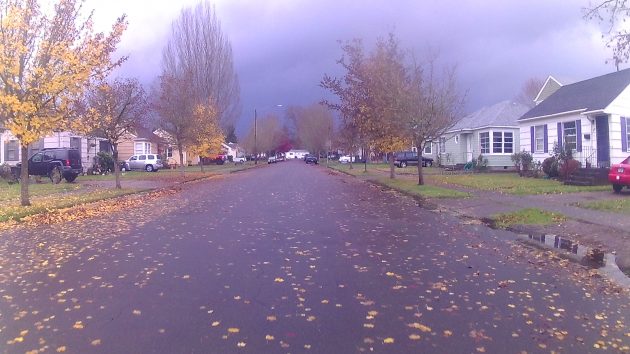
Wide open streets, no traffic: No-stress bike riding in Albany while rain threatens Tuesday afternoon.
There exists, you may be astonished to learn, a regional transportation plan for the “Albany metropolitan area.” And among many other things on its hundreds of pages, it rates existing “bicycle facilities” by their “levels of stress” or LTS.
People on bikes feel the least stress, the plan has discovered, on “separared facilities or shared roadways with low traffic speeds, low traffic volume, one lane in each direction, and intersections that are easy to cross.” The plan calls those conditions LTS 1.
The highest stress level, or LTS 4, comes about where there’s lots of traffic at high speeds on roads with many travel lanes and complex intersections. That is where, the plan says, riding a bike “requires experience and skill.”
The plan comes to this conclusion: “Bicycle facilities within central Albany have the lowest levels of stress, and those in outlying areas see higher levels of stress.”
If all this seems elementary, well, stating the obvious is what transportation plans often do. That’s why they are so thick. Including its supporting material, the 2018-2040 regional transportation plan of the Albany Area Metropolitan Planning Organization runs to 581 pages.
In any case, just to show what they mean by low-stress biking on city streets, try to stay awake during this seven-minute ride.
I was reminded of the regional plan when I watched an online meeting Tuesday night of the Albany Bicycle and Pedestrian Advisory Commission.
The commission heard of a new bicycle and pedestrian plan the metro planning organization is working up. Another plan may not be exactly what anybody needs, but what do you expect a “planning organization” to do other than make plans?
The new bike-ped plan is supposed to be done in about a year. Wait and see if it has more to say about the various levels of stress. (hh)

Here I’m checking the low levels of stress while riding the bike on residential Albany streets.

Plans are great…only if they get implemented. So seldom do these plans ever truly happen. But I guess they do provide jobs for city planners…albeit mostly unused wastes of taxpayer money. (From a longtime city Planning Commissioner, in a different city than locally.)
It seems to me, after reading “Plans”, “Proposals”, “Audit Reports” that, at some level those who write these missiles have had special training which provides them with the ability to ramble on and on but still say nothing.
There is an old saying , “if you can’t persuade with facts, baffle with BS.” IMO that is what most of these papers do.
I recently read a 24 page report that said absolutely nothing! I read it four times and still came away with the same questions.